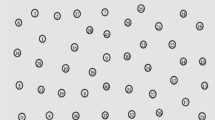Abstract
Microwave links are the obvious mobile backhauling solution for many mobile operators. Multi-hops are likely to be necessary in order to ensure connectivity for mobile backhaul solutions. The subject of the present paper is the evaluation of the connectivity of wireless multi-hop backhaul networks assuming high frequency transmissions among the relays. A novel analytical physical propagation and engineering model is presented for the calculation of the connectivity of wireless multi-hop networks that appropriate for operating frequencies above 10 GHz. Assuming equal power transmissions from every node and a random spatial node distribution following the homogeneous Poisson process, we calculate the node isolation probability. Furthermore, we calculate the minimum required node density in order to keep the backhaul network almost connected. The sensitivity of the isolation probability and of the minimum node density on frequency of operation, transmission power and climatic conditions is also investigated. Some useful conclusions are drawn.








Similar content being viewed by others
References
IEEE 802.16, “IEEE standard for local and metropolitan area networks—part 16: Air interface for fixed broadband wireless access systems,” (2009).
J. Wells, “Faster than fiber: The future of multi- G/s wireless,” IEEE Microwave Magazine 10 (3), 104–112 (2009).
S. Chia, M. Gasparroni, and P. Brick, “The next challenge for cellular networks: backhaul,” IEEE Microwave Magazine 10 (5), 54–66 (2009).
S. Little, “Is microwave backhaul up to the 4G task?” IEEE Microwave Magazine 10 (5), 67–74 (2009).
D. Lockie and D. Peck, “High-data-rate millimeter-wave radios,” IEEE Microwave Magazine 10 (5), 75–83 (2009).
Y.-C. Cheng and T. G. Robertazzi, “Critical connectivity phenomena in multi-hop radio models,” IEEE Transactions on Communications 37 (7), 770–777 (1989).
P. Gupta and P. R. Kumar, “The capacity of wireless networks,” IEEE Transactions on Information Theory 46 (2), 388–404 (2000).
C. Bettstetter and C. Hartmann, “Connectivity of wireless multihop networks in a shadow fading environment,” Wireless Networks 11, 571–579 (2005).
D. Miorandi, E. Altman, and G. Alfano, “The impact of channel randomness on coverage and connectivity of ad hoc and sensor networks,” IEEE Transactions on Wireless Communications 7 (3), 1062–1072 (2008).
O. Dousse, F. Baccelli, and P. Thiran, “Impact of interferences on connectivity in ad hoc networks,” IEEE/ACM Transactions on Networking 13 (2), 425–436 (2005).
R. K. Crane, Electromagnetic Wave Propagation Through Rain (Wiley, New York, 1996).
Y. Li and J. Huang, “Rain attenuation at millimeter wavelengths,” International Journal of Infrared and Millimeter Waves 23 (7), 1119–1126 (2002).
F. Moupfouma, “Electromagnetic waves attenuation due to rain: A prediction model for terrestrial or L.O.S SHF and EHF radio communication links,” Journal of Infrared, Millimeter and Terahertz Waves 30 (6), 623–633 (2009), June.
A. D. Panagopoulos and J. D. Kanellopoulos, “Statistics of differential rain attenuation on converging terrestrial propagation paths,” IEEE Transactions on Antennas and Propagation 51 (9), 2514–2517 (2003).
A. D. Panagopoulos and J. D. Kanellopoulos, “Differential rain attenuation statistics on two converging point-to-point terrestrial links located in a tropical climatic region,” Annals of Telecommunications 58 (3–4), 673–677 (2003).
ITU-R Recommendation P. 837-5, “Characteristics of precipitation for propagation modeling,” Propagation in Non-Ionized Media (Geneva, 2007).
Author information
Authors and Affiliations
Corresponding author
Rights and permissions
About this article
Cite this article
Pitsiladis, G.T., Panagopoulos, A.D. & Constantinou, P. Multi-Hop Wireless Backhaul Networks above 10 GHz: Connectivity and Critical Density Evaluation. J Infrared Milli Terahz Waves 31, 329–340 (2010). https://doi.org/10.1007/s10762-009-9594-3
Received:
Accepted:
Published:
Issue Date:
DOI: https://doi.org/10.1007/s10762-009-9594-3




